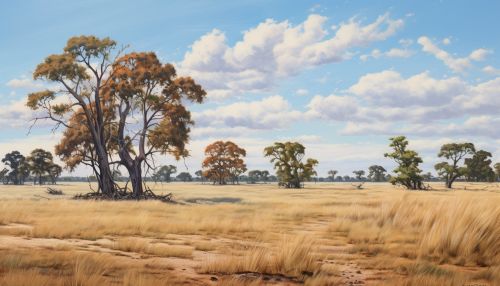Tropical savanna climate
Overview
The Tropical savanna climate or tropical wet and dry climate is a type of climate that corresponds to the Köppen climate classification categories "Aw" and "As". This climate is characterized by a distinct wet season and a dry season, with the highest monthly average temperature being above 18 °C (64 °F) during all months of the year. The tropical savanna climate is often found in the tropics, typically bordering the tropical rainforest climate.
Characteristics
Tropical savanna climates have monthly mean temperature above 18 °C (64 °F) in every month of the year and typically a pronounced dry season, with the driest month having precipitation less than 60mm of precipitation. The Köppen Climate Classification subtype for this climate is "Aw" (Tropical Savanna Climate).
The length and severity of the dry season diminishes inland (away from the ocean) with a decrease in latitude. Vegetation in areas with a tropical savanna climate is generally a mixture of grasses and trees, though the type and density of vegetation can vary depending on the amount of rainfall.


Distribution
Tropical savanna climates are most commonly found in Africa, Asia and South America. The climate is prevalent in countries such as Brazil, India, and Australia. It is also found in sections of Central America, the Yucatan Peninsula, and in the southernmost portions of the United States, such as Florida.
Vegetation
The vegetation of a tropical savanna climate varies due to the amount of rainfall. In some savannas, grasses are the dominant vegetation, with scattered trees. In other savannas, the density of the trees can increase to the point that they form a woodland. The type of vegetation can also change with the amount of rainfall, with more water-demanding species growing in wetter savannas.
Wildlife
The wildlife in tropical savanna climates is diverse and includes a variety of large grazing mammals, such as zebras and wildebeest. These animals are well adapted to the sparseness of the vegetation and the long dry season. Predators, such as lions and cheetahs, are also common in these areas.
Human Adaptation
Humans have adapted to life in the tropical savanna climate in various ways. Many people living in these areas are involved in agriculture, particularly the raising of livestock. The dry season can be challenging for farming, and so irrigation and other water conservation techniques are often used.
Impact of Climate Change
Climate change is expected to have significant impacts on tropical savanna climates. Changes in rainfall patterns could lead to changes in the vegetation and wildlife. Increased temperatures could also lead to increased evaporation, exacerbating the dry season.
